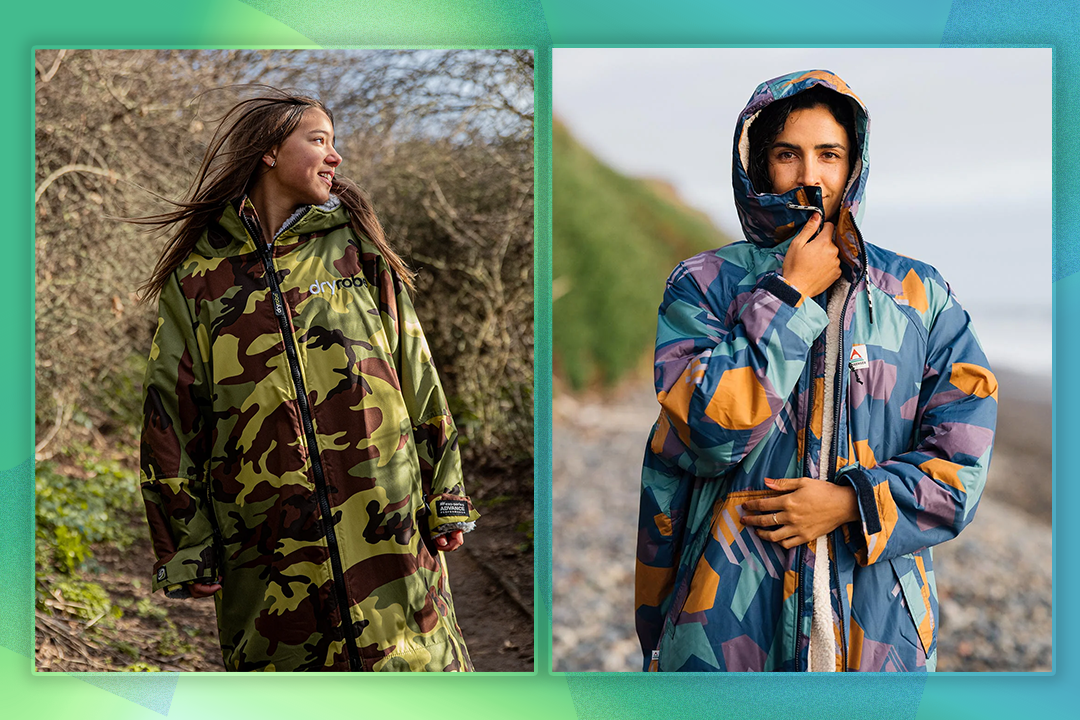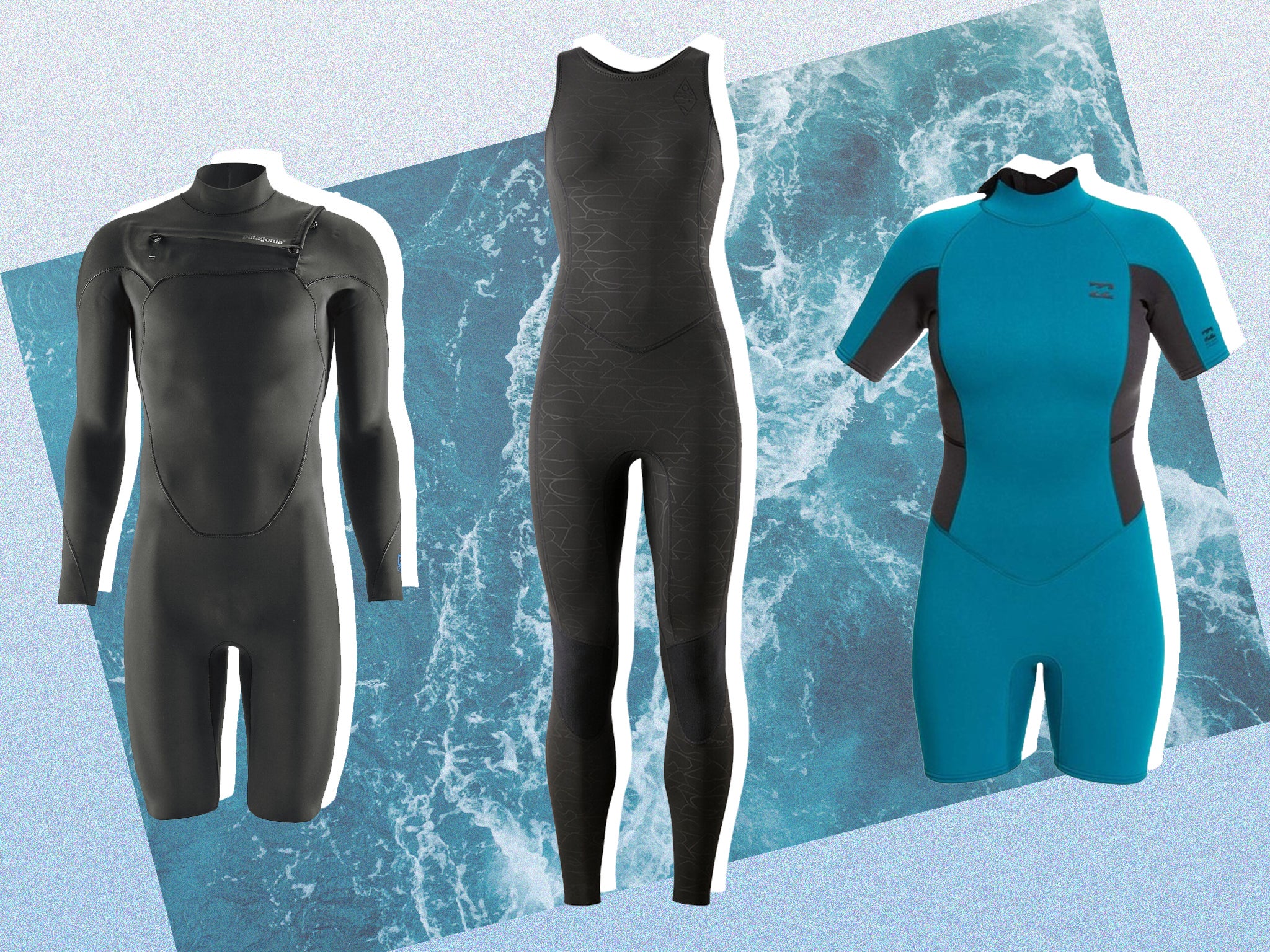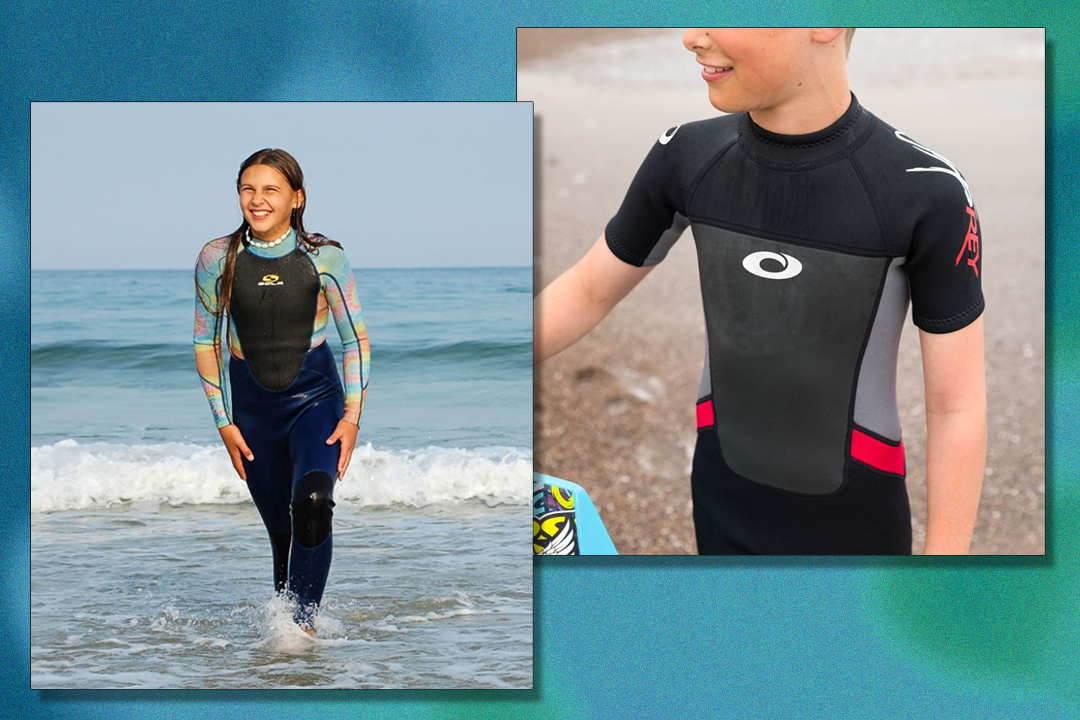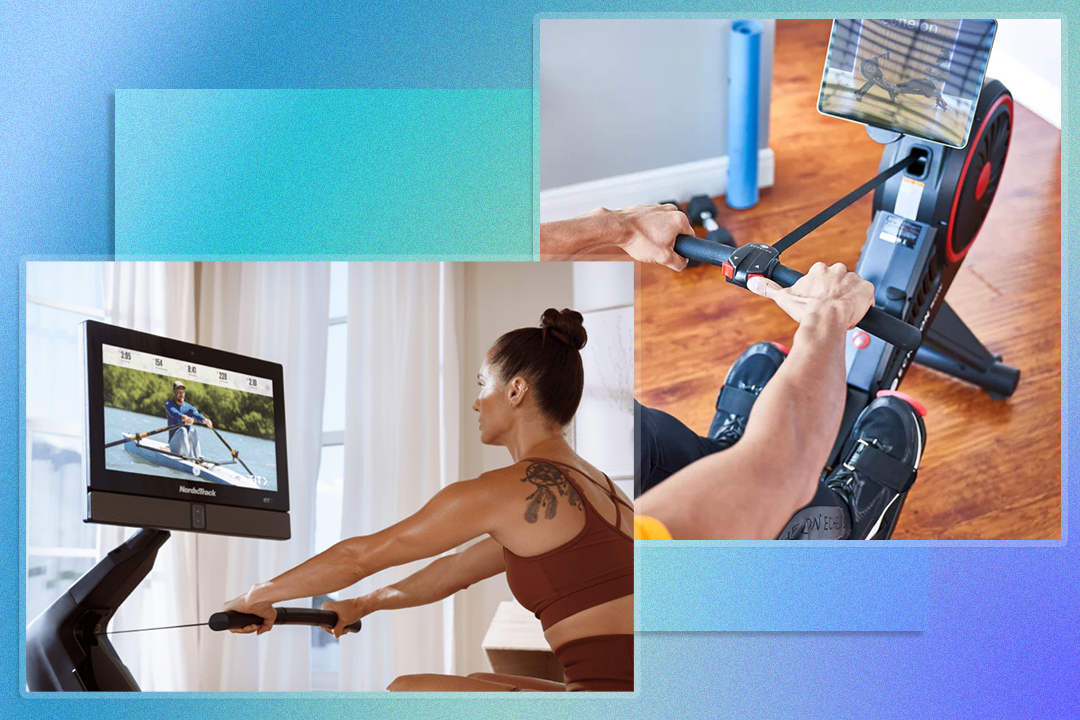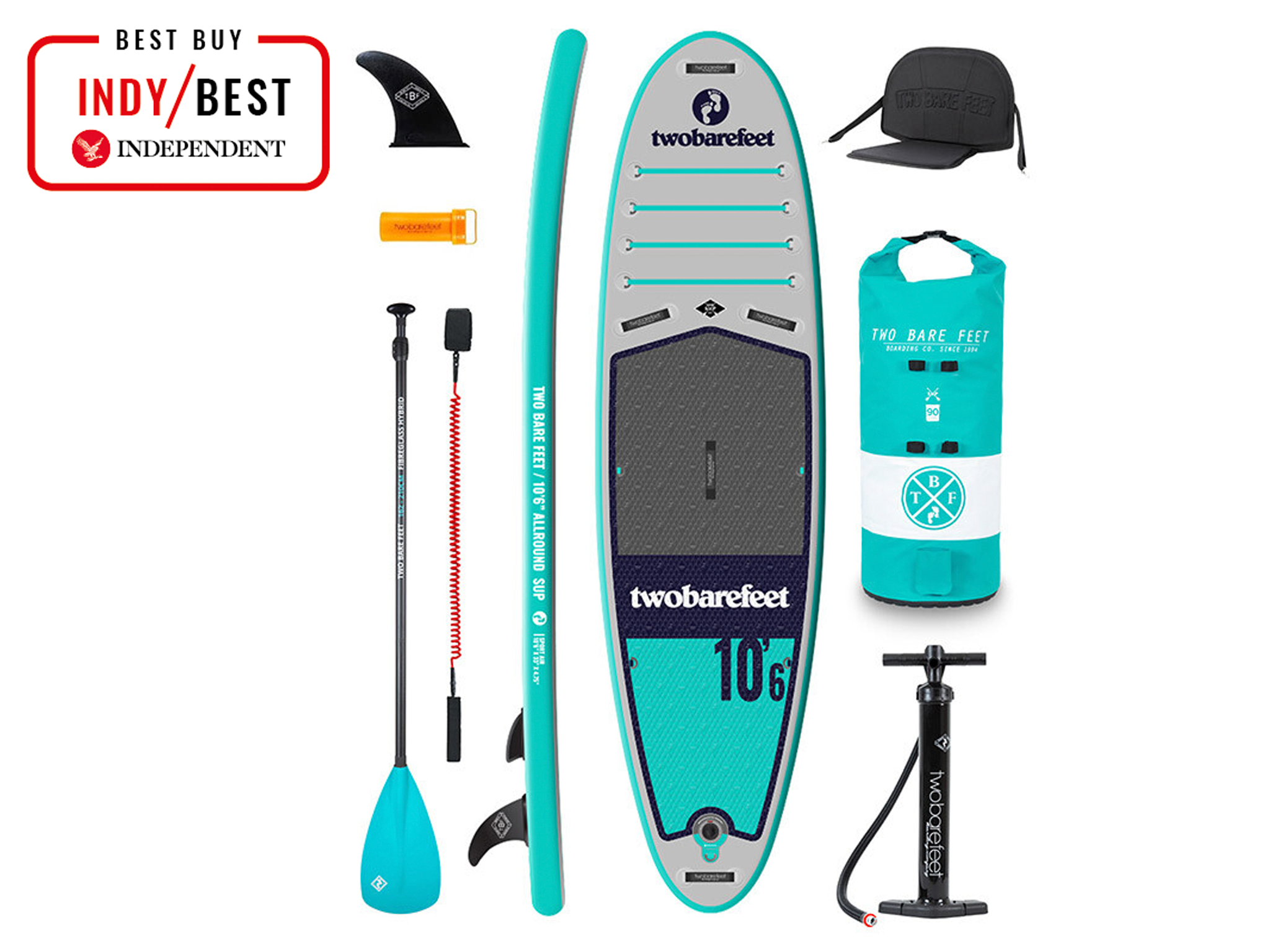
The Independent's journalism is supported by our readers. When you purchase through links on our site, we may earn commission. Why trust us?
14 best inflatable stand-up paddleboards for fun on the water
Whether you’re a paddling pro or boarding beginner, these are the best SUPs to buy
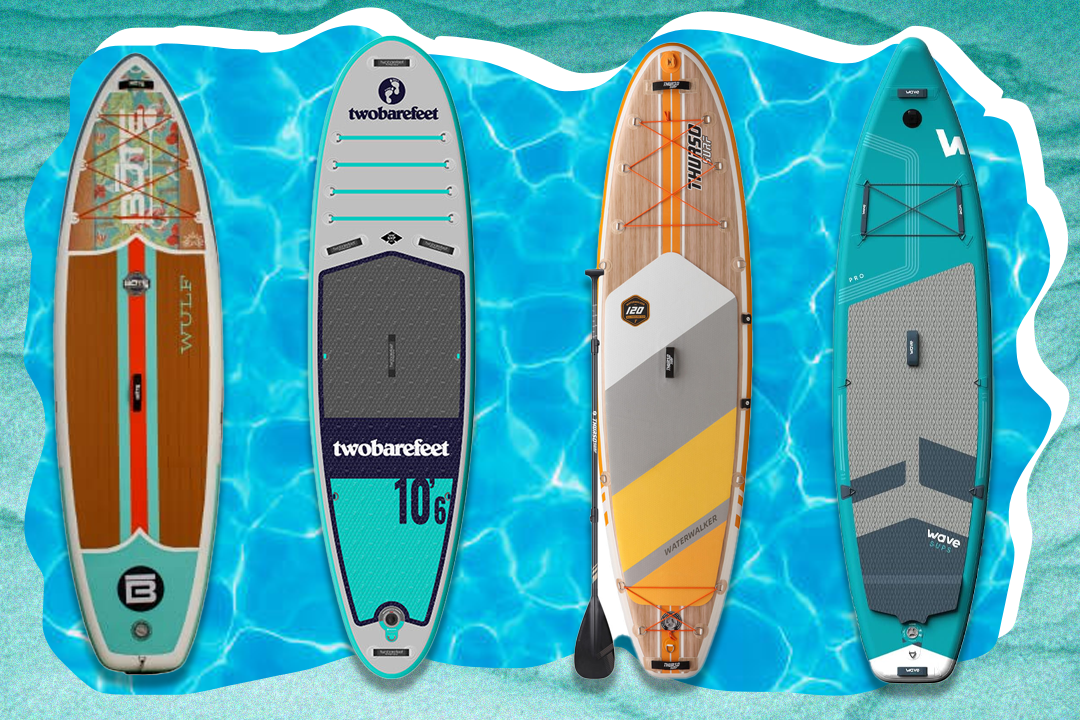
This year, on the UK’s beaches, riverbanks and lakeshores, the sound of stand-up paddleboards (SUPs) being inflated is likely to be as common as that of the howling toddler who’s just dropped their ice cream.
It’s easy to see why, too, as inflatable boards have made paddleboarding inclusive, inexpensive and lots of fun, no matter what your experience level. If you are just starting out, the whole thing might seem a bit daunting, but you just have to make sure you’re standing on the right kind of board for your body type and skill level.
Minimising the wobble factor is important when you first step on – stability is key when it comes to relaxing and building confidence, so you can concentrate on your paddling technique. This usually means a shorter, wider board with lots of volume, so it sits higher on the water and doesn’t sink into the drink. Generally, every board comes with a capacity measurement or max rider weight. If you’re within 50lbs of a board’s listed capacity, you should look at choosing another board with a larger capacity.
As you progress and start to find your sea legs, you’ll need less volume but more length and a thinner deck, so you can really cut through the water at speed. This way, you’ll easily be able to cover lots of distance quickly.
No matter how experienced you are, some attributes should be common to every SUP. They need to be quick to inflate and deflate, with intelligently located handles for good portability in and out of the water. When you are on the water, you’re going to want a good non-slip deck that’s comfortable to stand on, as well as cargo areas (in the form of bungee straps) to transport everything you want to take with you.
If you want to know which SUP to buy, let us guide you to some of the boards that have really got us pumped this year.
How we tested the best stand-up paddleboards
We took to the water off the South Devon coastline, setting off from the beach, paddling to an estuary and on up the river, so we could truly test the boards in different kinds of water.
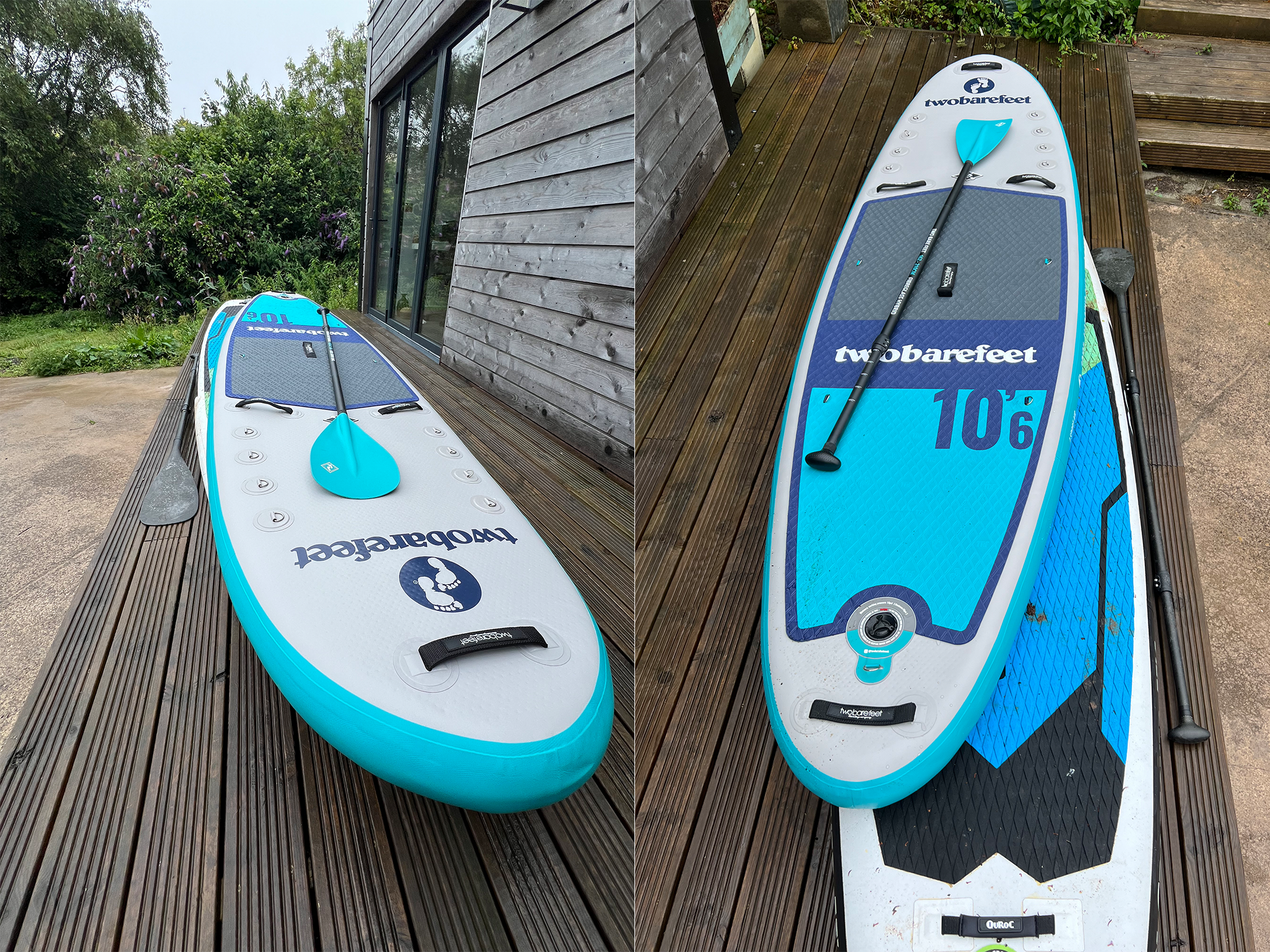
Obviously, inflation systems (yes, we mean the pump) are pretty important when it comes to an inflatable paddleboard, but pumps have come a long way from the days when blowing up an inflatable on the beach would leave you a sweaty mess. All the boards included below were easy and quick to inflate, especially those that came with high-pressure double-action pumps.
The best stand-up paddleboards for 2024 are:
- Best overall – Two Bare Feet sport air 10ft 6in fibreglass paddleboard: £485, Twobarefeet.co.uk
- Best budget buy – Wave woody SUP package: £279.99, Therange.co.uk
- Best for kids – Red Paddle Co snapper: £799, Supinflatables.co.uk
- Best for pros – Wave pro SUP package: £349.99, Amazon.co.uk
Two Bare Feet sport air 10ft 6in fibreglass paddleboard

- Best: Overall
- Length: 10ft 6in
- Width: 33in
- Depth: 4.75in
- Volume: 250l
- Max rider weight: 150kg (95kg recommended for beginners)
- Package: Backpack, dual-action pump, repair kit, and removable kayak seat
- Why we love it
- You can decide between two-piece or three-piece paddles
- Thinner board
A good all-rounder from a UK manufacturer, this SUP hits the sweet spot when it comes to stability, without it feeling unwieldy to paddle around. This is mainly due to a wider nose and tapered tail, which adds lots of control when moving forward.
There’s also a lot of volume up front, so, if you’re loading up the cargo area, the board’s performance won’t be adversely affected. This means it’s a great board for taking your four-legged companion with you, as dogs invariably end up at the front, either readying themselves to jump in or just generally looking confused.
The slightly thinner width makes this SUP quick through the water if you’re adept with the paddle, whereas, if you’re paddling technique is a work in progress, the board’s slimmer depth and lower centre of gravity in the water will provide plenty of control, while boosting confidence.
The materials used and the construction of the board itself makes it one of the most durable we tested, which is good news, as the package comes with a river fin and sea fin.
Wave woody SUP package
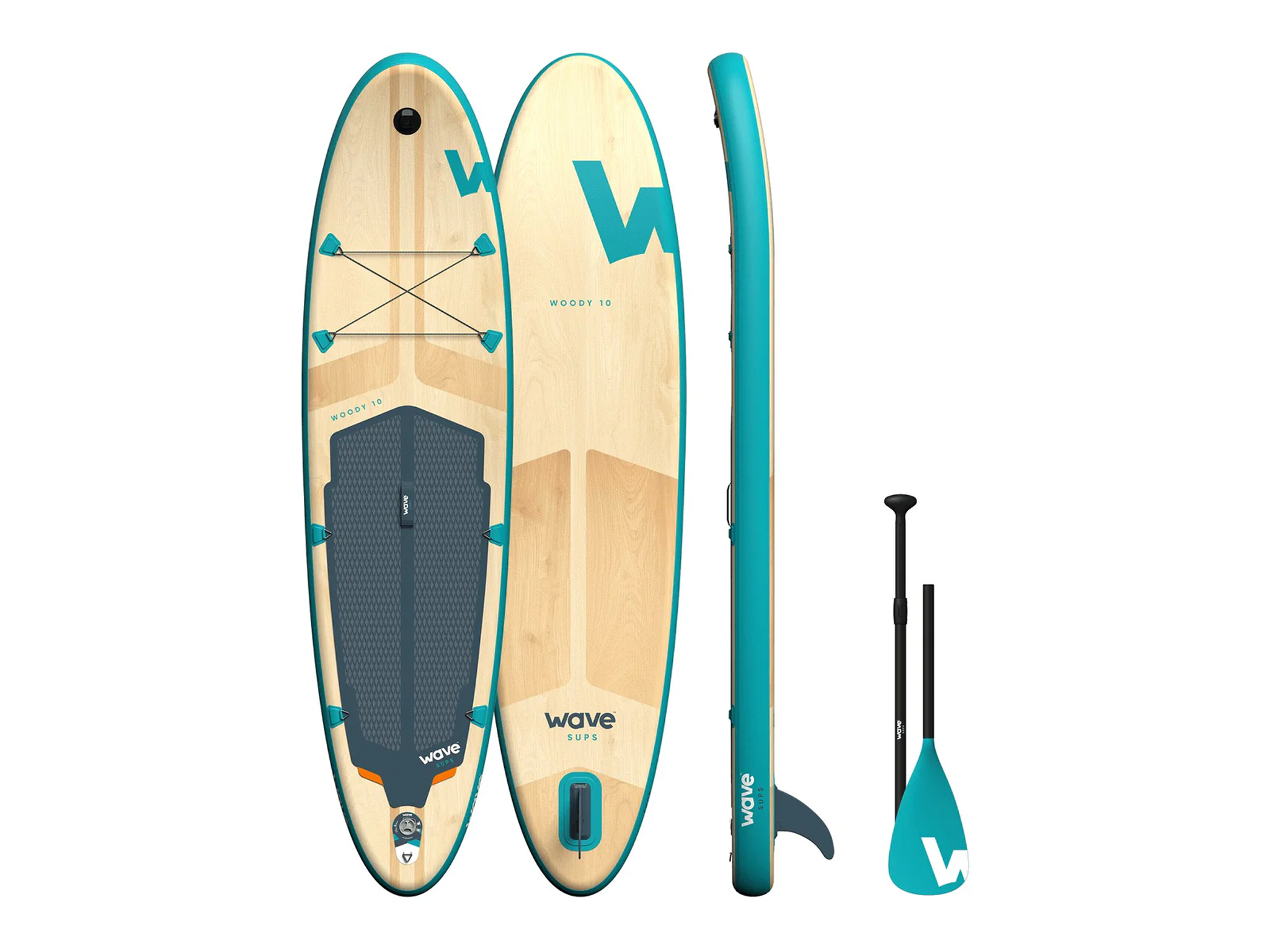
- Best: Budget buy
- Length: 10ft or 11ft
- Width: 32in
- Depth: 6in
- Volume: 260l
- Max rider weight: 130kg
- Package: Paddle, detachable fin, dual-action pump, padded coiled ankle leash, repair kit and backpack
- Why we love it
- Stable through the water
- Plenty of foot friction
- GoPro mount
This board will certainly turn a few heads as you walk down the beach, with its wood-effect deck. It’s also nice and wide, which makes it a good option for paddlers who are gaining confidence and looking for a replacement for their first board.
The SUP is available in two lengths (10ft and 11ft). We trialled the 11ft, which suited our tester’s height and was very stable through the water.
The rubber offers plenty of foot friction, so you don’t feel like you’re going to slip around as you put more effort into your stroke, and the comfortable leash works with your movements on the board.
A mid-board handle is ergonomically placed to help you get it to the water’s edge, and there are lots of extras for a beginners’ board in this price range. These include a GoPro mount and D-rings, which can increase the storage on the board, if you’re heading off on a multi-day adventure, or even secure a seat if you want to convert it to kayak mode.
Thurso surf waterwalker 126 all-around SUP
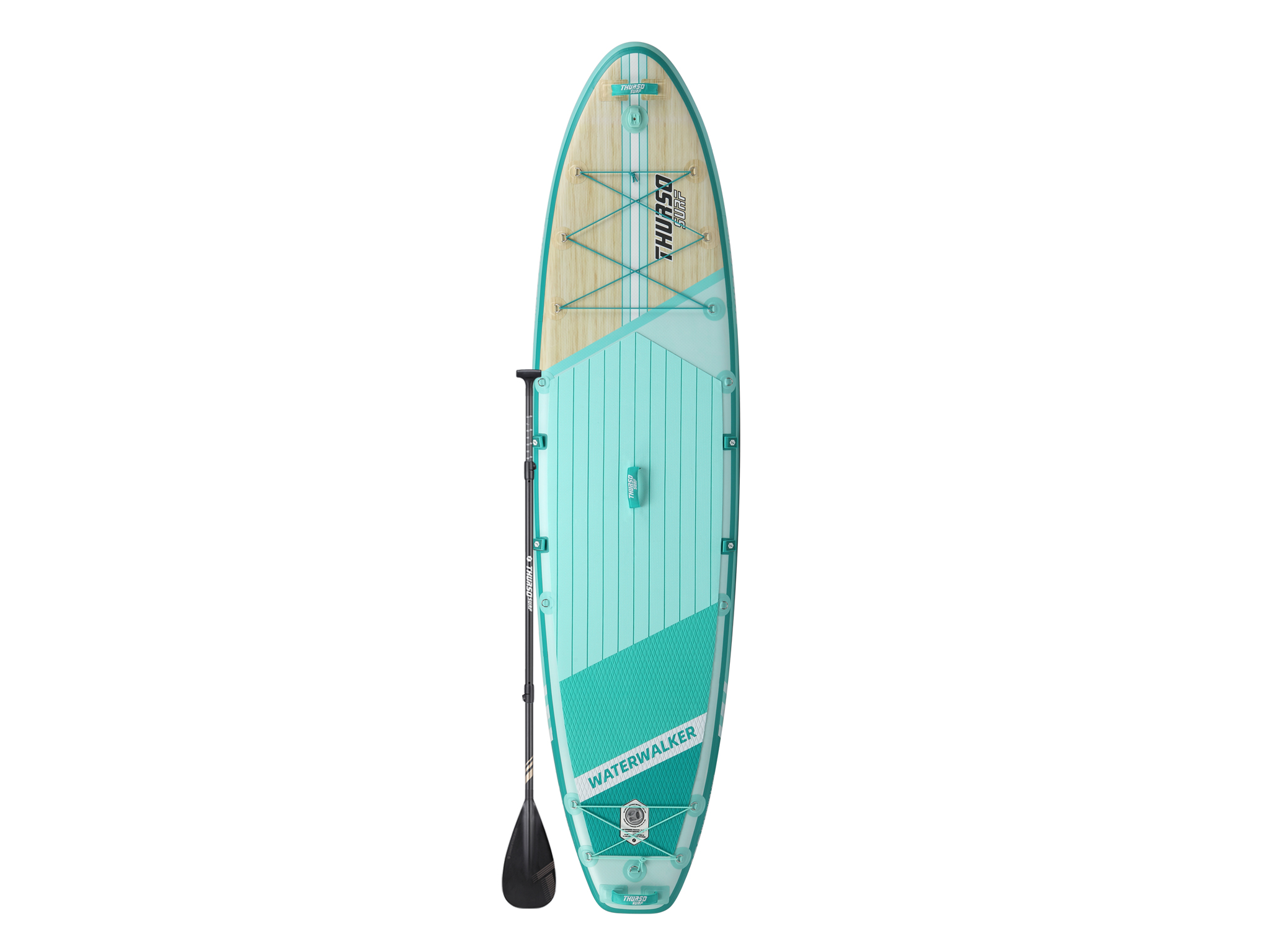
- Best: For speed
- Length: 10ft 6in
- Width: 31in
- Depth: 6in
- Volume: 270l
- Max rider weight: 135kg (58-81kg recommended for beginners)
- Package: Paddle, rechargeable electric air pump, backpack, leash and fins
- Why we love it
- Very quick
- Adapts to lots of conditions
We really liked the shape of this 10ft 6in board, and we liked it even more when we got it out on the water, as it’s very quick.
This is a good option for the more confident riders out there, as it’s adaptable to seas, rivers and lakes. Plus, its shape, design and weight enable you to try out manoeuvres such as the step-back turn, where you shift your body to the back of the board and lift up the nose, so you turn more easily out of tight spots.
Quick inflation and the addition of Velcro straps for securing your paddle when you’re not using it are also very welcome, as is the inclusion of an electric air pump in the package, which takes all the effort out of getting the waterwalker ready to use.
Quroc allwater 12ft 6in touring SUP package

- Best: For touring
- Length: 12ft 6in
- Width: 30in
- Depth: 6in
- Volume: 345l
- Max rider weight: 110kg
- Package: Paddle, backpack, board backpack, pump, fins, repair kit, leash and belt
- Why we love it
- Copes well with choppy conditions
The allwater from Quroc is perfect if you’re looking for a more advanced board, as its shaping is such that it improves paddling without making any compromise on stability.
The extra length you get with this 12ft 6in ride makes it the perfect point-and-shoot board for touring. Just find your heading and it’ll track superbly, no matter how hard you’re paddling.
As the name suggests, it’s built to be adventurous, and the increased volume means it can cope brilliantly with choppy sections of the sea and stays stable in the wind – it even performs against a turning tide. All it takes is a little extra effort on the paddle and you can get to any target quickly.
Red Paddle 10ft 8in activ MSL inflatable yoga paddle board package
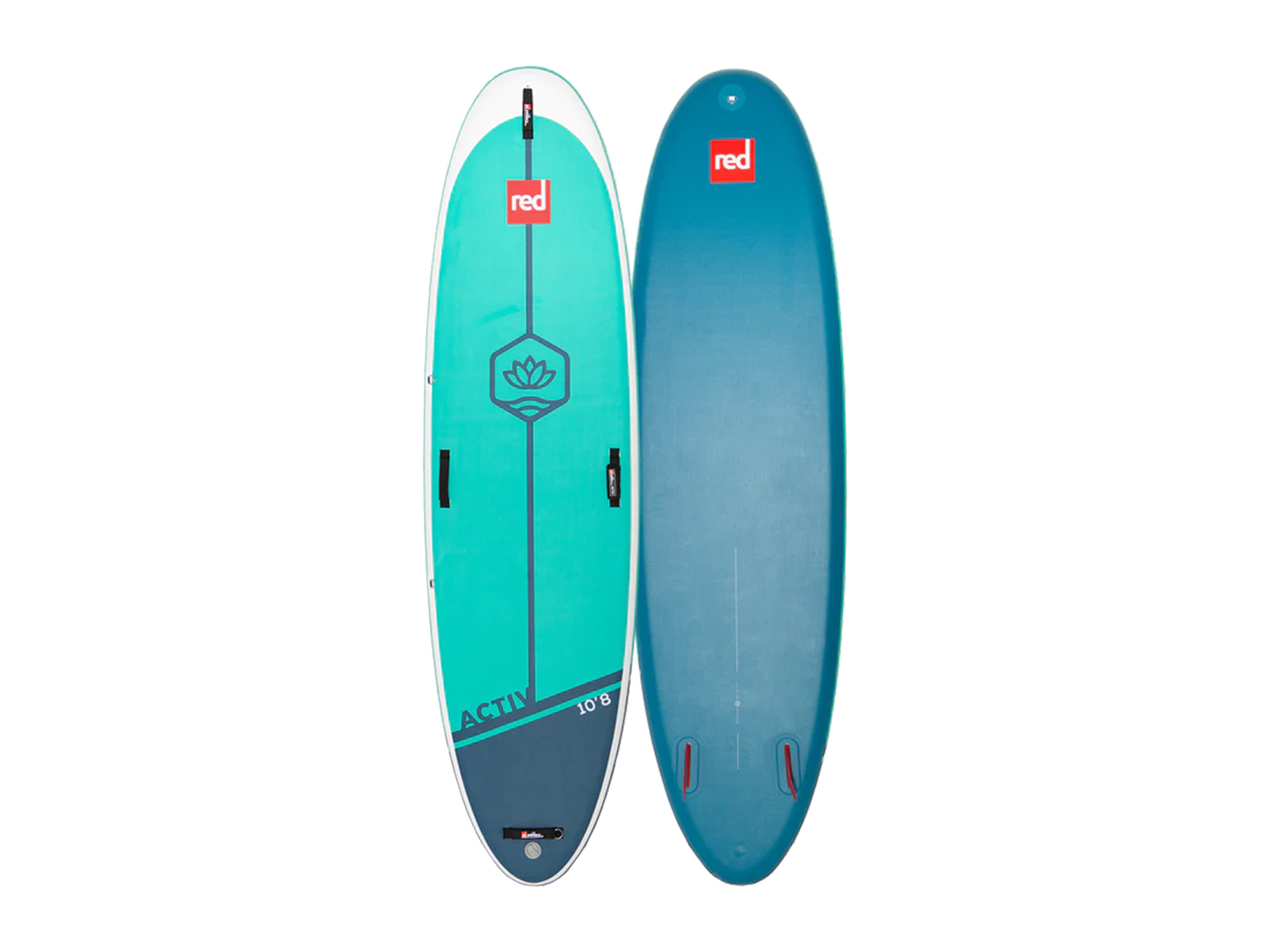
- Best: For yoga
- Length: 10ft 8in
- Width: 34in
- Depth: 5.9in
- Volume: 160l
- Max rider weight: Unspecified
- Package: Backpack, pump, leash, paddles, fin
- Why we love it
- Great stability
- Made with yoga in mind
Yoga mats are yesterday’s news. Yoga paddleboards (YSUPs), however, offer the chance to take your practice to the next level.
Obviously, stability becomes even more important for aqua asanas, and this board offers up 333l of volume and a deck that’s 34in wide and 10ft 8in long, so your downward dog won’t turn into a drowned rat. The blunt-nose shape keeps the board steady, and, when maximally inflated, it offers a good hard surface on which to practise.
Red has conceptualised the board well for yoga, too, moving the carry handles to the side of the board, so they don’t get in the way of your flow, and by including Velcro straps to stow your paddle while you’re in warrior pose.
Fanatic allwave paddle board
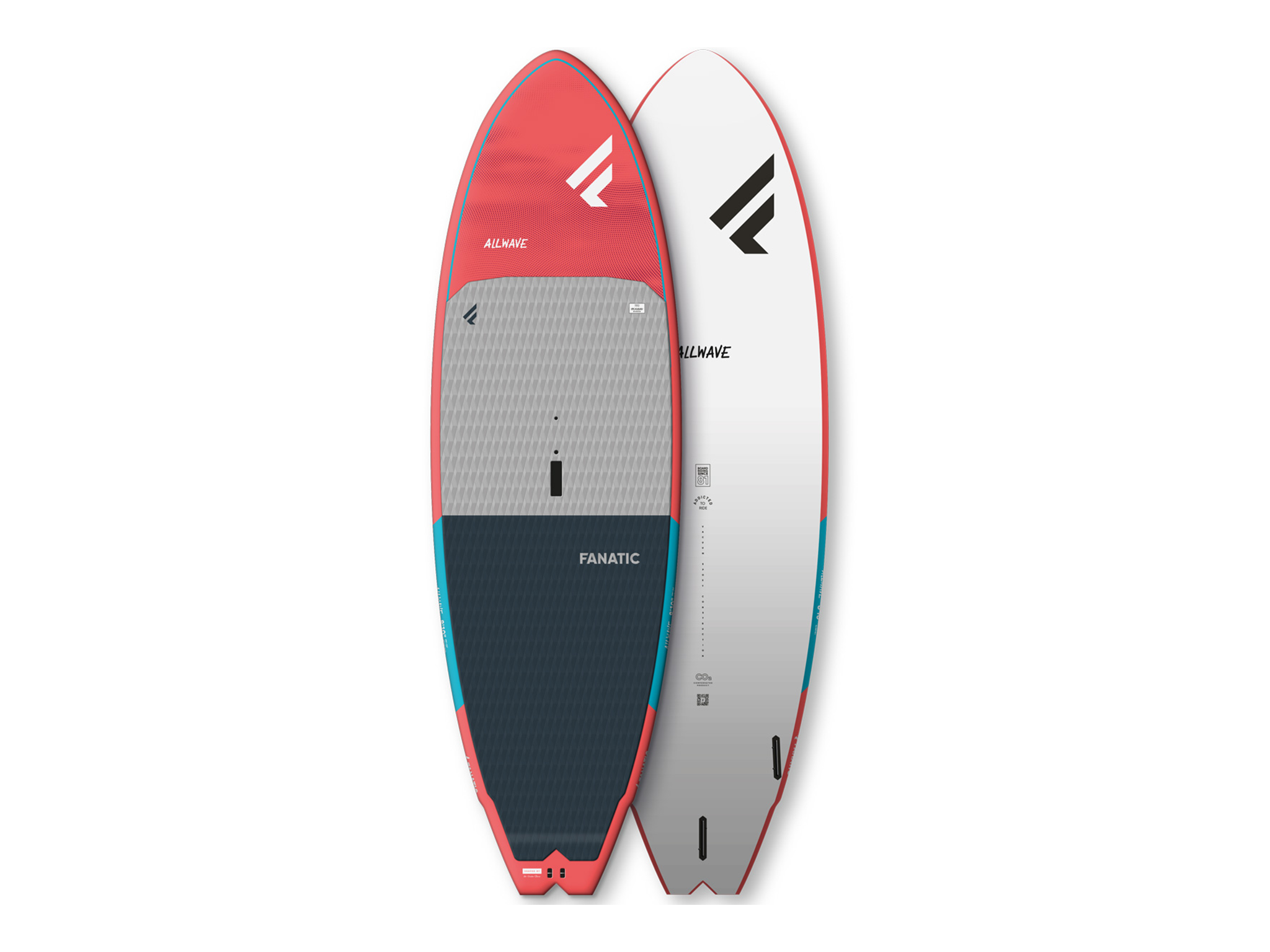
- Best: Paddleboard for surfers
- Length: 7ft 9in
- Width: 28.5in
- Depth: 6in
- Volume: 105l
- Max rider weight: Unspecified
- Package: Pressure vent screw, 3 x allwave 5in RTM
- Why we love it
- Combines paddle boarding and surfing
Whether you’re a surfer keen to try out paddleboarding or a paddleboarder keen to try out surfing, the allwave is well-equipped to give you the best possible chance of doing both.
With plenty of volume, the allwave sits quite low in the water, boosting stability and therefore confidence when taking on the waves. There’s a new swallow-tail design, too, which allows for some easy turning, even in some quite messy waters.
With five sizes to choose from, ranging from 7ft 9in (which we had on test) all the way up to 9ft 2in, you can match the length to your height, weight and competence.
Red 9ft 4in 3-in-1 snapper MSL kids' inflatable paddle board package

- Best: For kids
- Length: 9ft 4in
- Width: 27in
- Depth: 4in
- Volume: 134l
- Max rider weight: 60kg
- Package: Backpack, pump, leash, paddle, windsurf rig and fins
- Why we love it
- Can switch between SUP, windsurfing or surfing modes
This Devon-based manufacturer is always innovating and it’s come up with a great way for kids to make the most of their time on the water. The brand’s three-in-one board can switch between SUP, windsurfing or surfing modes, thanks to detachable handles and fins.
It was the performance of the snapper as an SUP that we were most interested in, and our pint-sized paddler had an absolute blast on the board. It strikes a good balance between width, volume and narrowness, so it’s easy for smaller ones to get their paddle in the water and make progress.
Its 27in width offers stability while keeping the fun factor and responsiveness for quicker turns and playing in the waves. A robust core also means the board can take plenty of punishment.
Wave pro SUP package
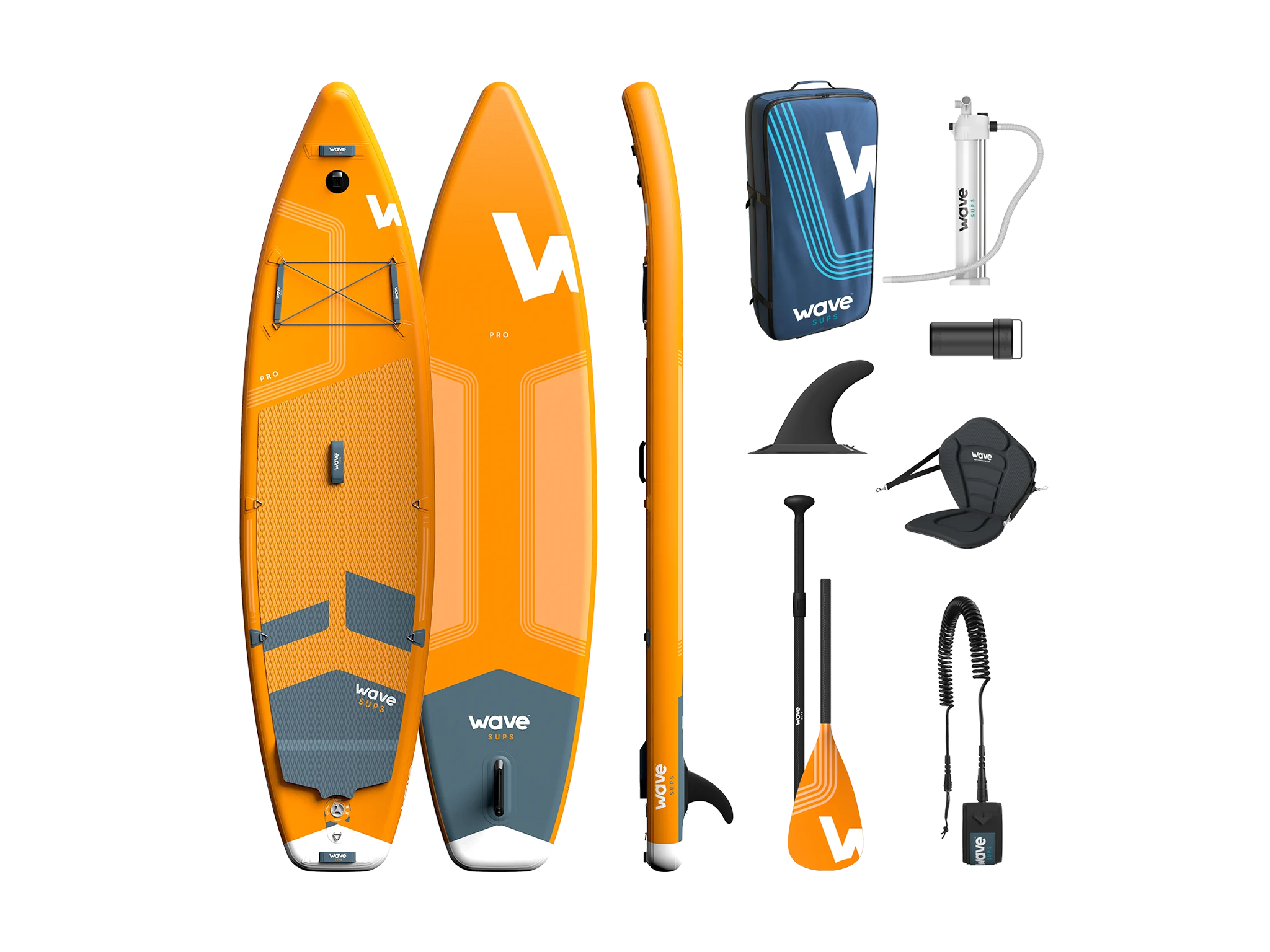
- Best: For pros
- Length: 11ft
- Width: 33in
- Depth: 6in
- Volume: 175l
- Max rider weight: 140kg
- Package: Paddle, backpack, fin, seat, pump, leash and repair kit
- Why we love it
- Narrow nose cuts through choppy water
- Comfortable and grippy deck
We took the pro out in some pretty choppy conditions and it performed brilliantly, thanks to its narrow nose, which is shaped and curved to be able to tame rough water, whether you’re in the sea or on a river.
The deck is comfortable, grippy, and well-suited to take the aches and pains out of a day’s paddling. The double-walled construction means the pro is rugged enough to ride out meetings with rock and river banks. Five padded handles make the board easy to port around, and there’s a cargo bungee at the front of the board to store a dry bag.
Well accessorised with a GoPro mount and seat-friendly D-rings, this is a board for adventurous paddlers who are keen to document their journey.
Thurso Surf waterwalker 132 all-around SUP
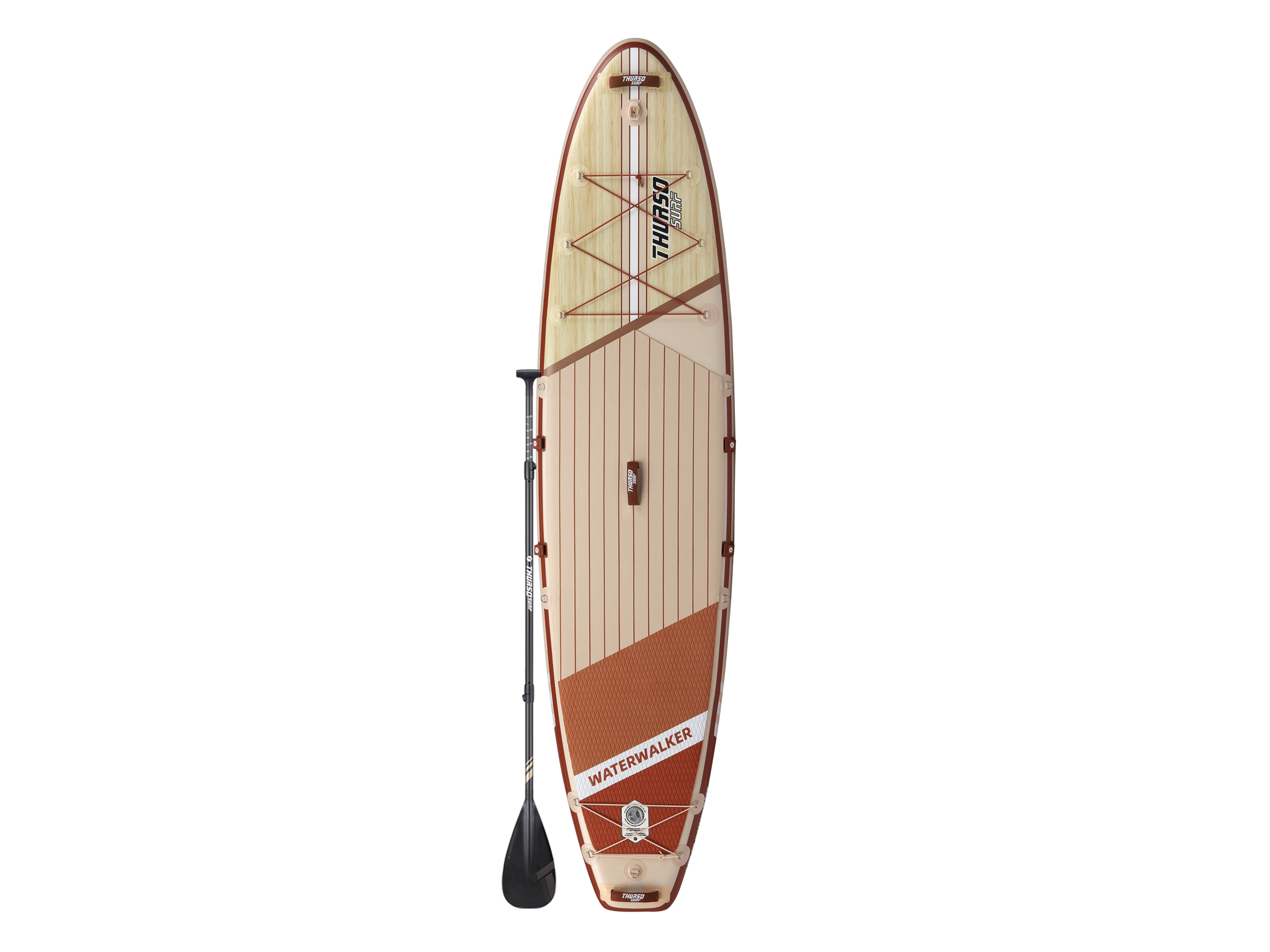
- Best: For stability
- Length: 10ft 6in
- Width: 33in
- Depth: 6in
- Volume: 322.5l
- Max rider weight: 149kg (72-95kg recommended for beginners)
- Package: Electric pump, backpack, paddle, fins and leash
- Why we love it
- Perfect for adventuring
If you want to banish the wobble factor that plagues many beginners, the larger size of the previously mentioned waterwalker is the most stable platform we paddled.
Even though it shares the same name, this 132 board has very unique paddling characteristics, and its 31in width and squared-off tail minimises side-to-side movement and is a real confidence booster, even when you’re picking up speed.
The 132 is really well made and you won’t have to worry about damage if you get too close to jagged rocks while you’re adventuring, either. The inclusion of an electric pump and one of the most compact and comfortable backpacks on test only add to the board’s appeal.
Bote wulf aero paddle board
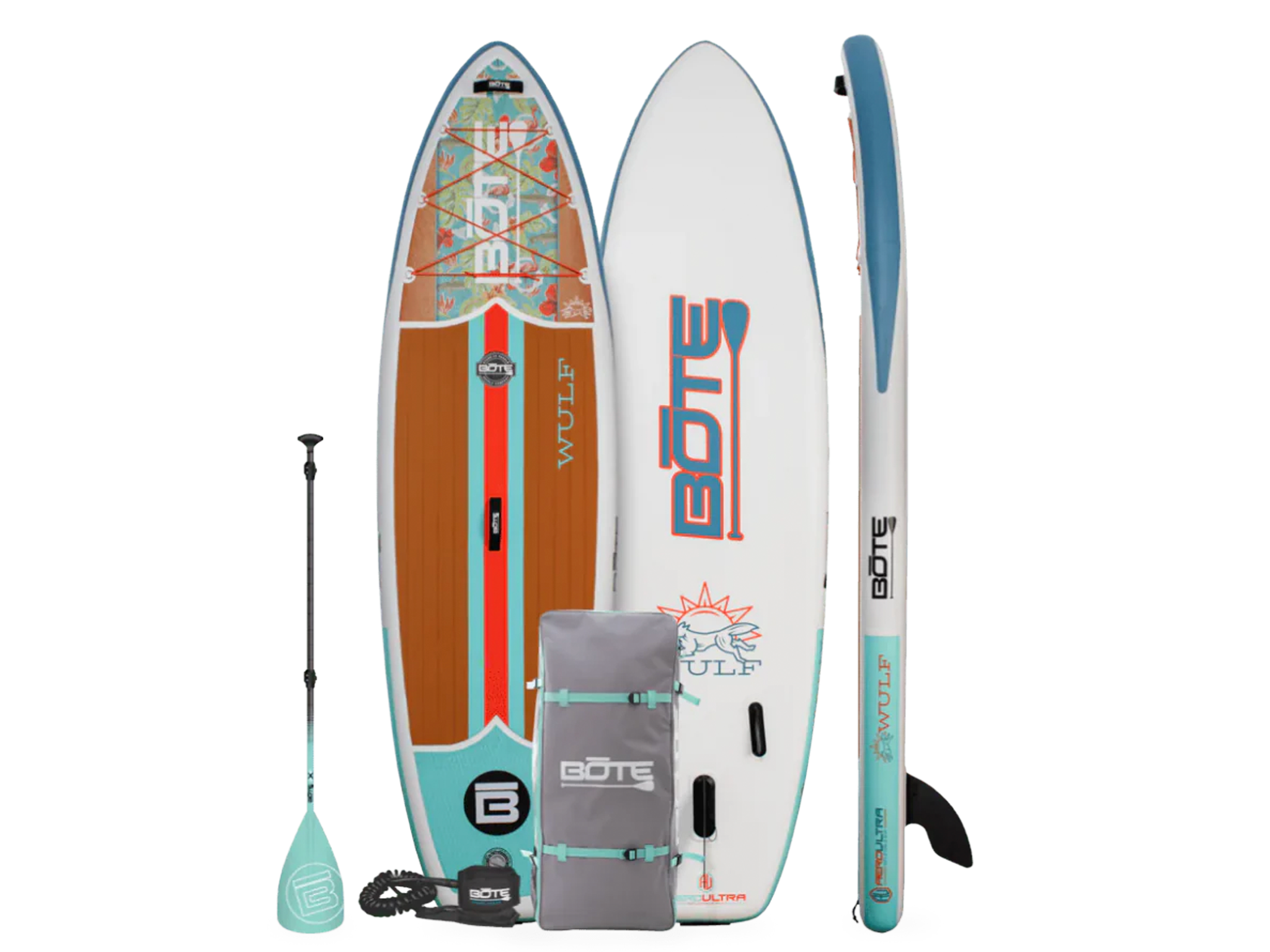
- Best: For adventurous beginners
- Length: 10ft 6in or 11ft 4in
- Width: 34in
- Depth: 6in
- Volume: Unspecified
- Max rider weight: 113kg
- Package: Backpack, paddle, safety leash, repair kit and hand pump
- Why we love it
- Good handling
- Looks great
When you’re starting out, it’s vital the board beneath your feet imparts lots of confidence, and that’s certainly what you get with this recently redesigned SUP. It’s a great all-rounder, thanks to a 34in-wide deck that offers riders bags of stability, while the more pointed nose means you can pick up speed quickly, if you want to.
The wulf aero is constructed from a tough PVC skin, making it very durable and suitable for all water courses as well as the sea. However, the technology used by the American manufacturer keeps the board lightweight, so it’s never a struggle to get it to the water.
One of the things we loved the most was that the redesign allows for compatibility with Bote’s Magnepod system, which means you can head out with anything from a drinks bottle to a can cooler safely secured in its magnetic attachment that’s built into the board. So, even if you do end up in the water, your Bluetooth speaker won’t follow you in.
Thurso waterwalker 120
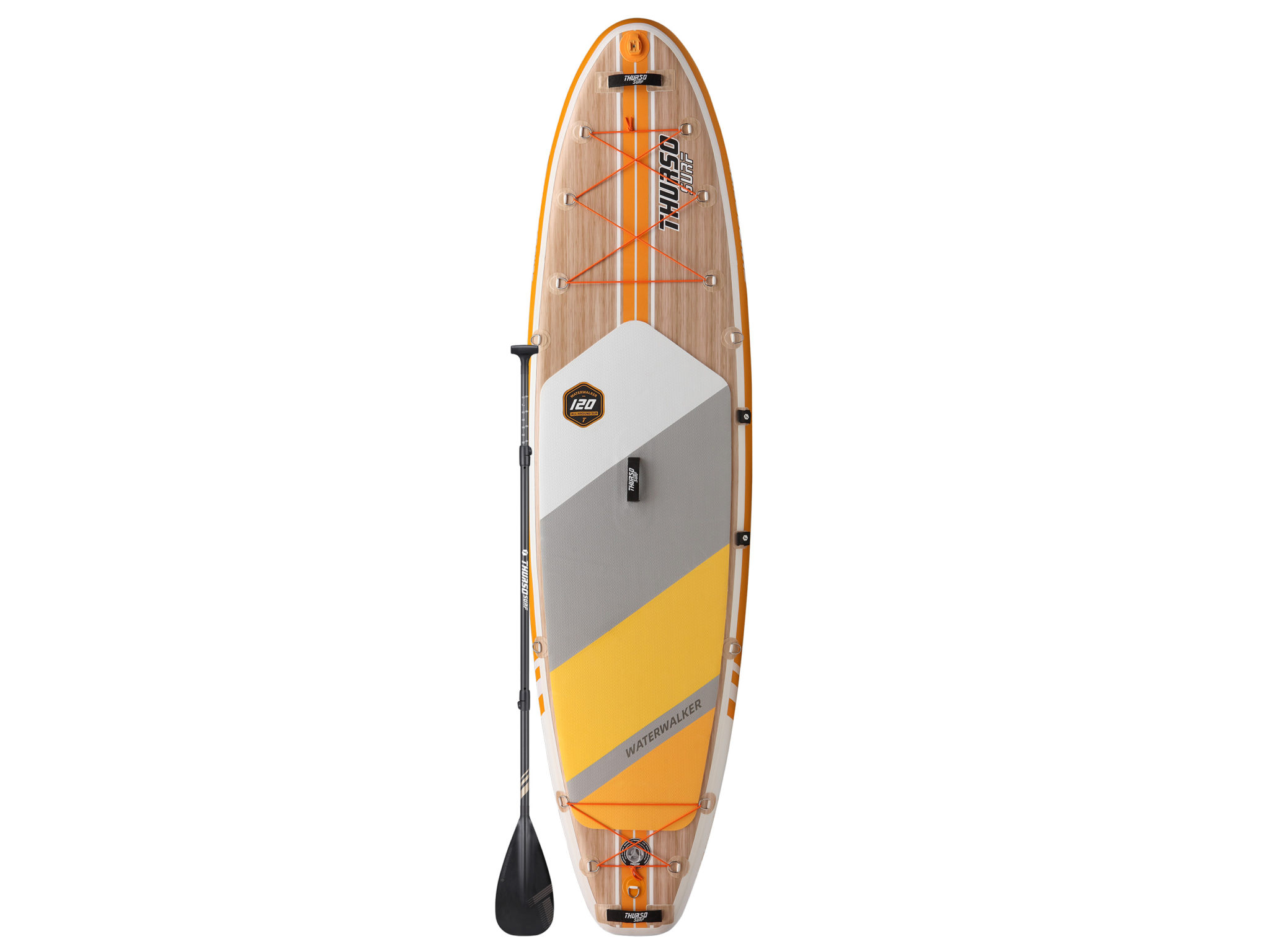
- Best: Hybrid
- Length: 10ft
- Width: 30in
- Depth: 6in
- Volume: 240l
- Max rider weight: 45-70kg
- Package: Three-piece paddle, backpack, pump and safety leash
- Why we love it
- Very versatile
- Nice detailing
Another, shorter version of the waterwalker, this 10ft SUP impressed us with its all-around performance. Keeping the design of its more-elongated siblings, with its squared off tail, the 10ft version keeps any confidence-sapping, side-to-side movement to a minimum, which is great when you’re picking up speed.
The design also really highlights the board’s hybrid capabilities, just add the nicely padded Thurso surf kayak seat (£59.99, Amazon.co.uk), using the D-rings, and the board turns into an excellent hybrid paddler. Like the other waterwalkers in the series, this one is well-crafted and robust, with a nice textured deck pad if you’re off touring.
Included are three comfortable handles, bungee cargo areas at the nose and tail, and a handy paddle holder, if you want to take a break and chill out for a bit.
Wave tourer 2.0 paddle board
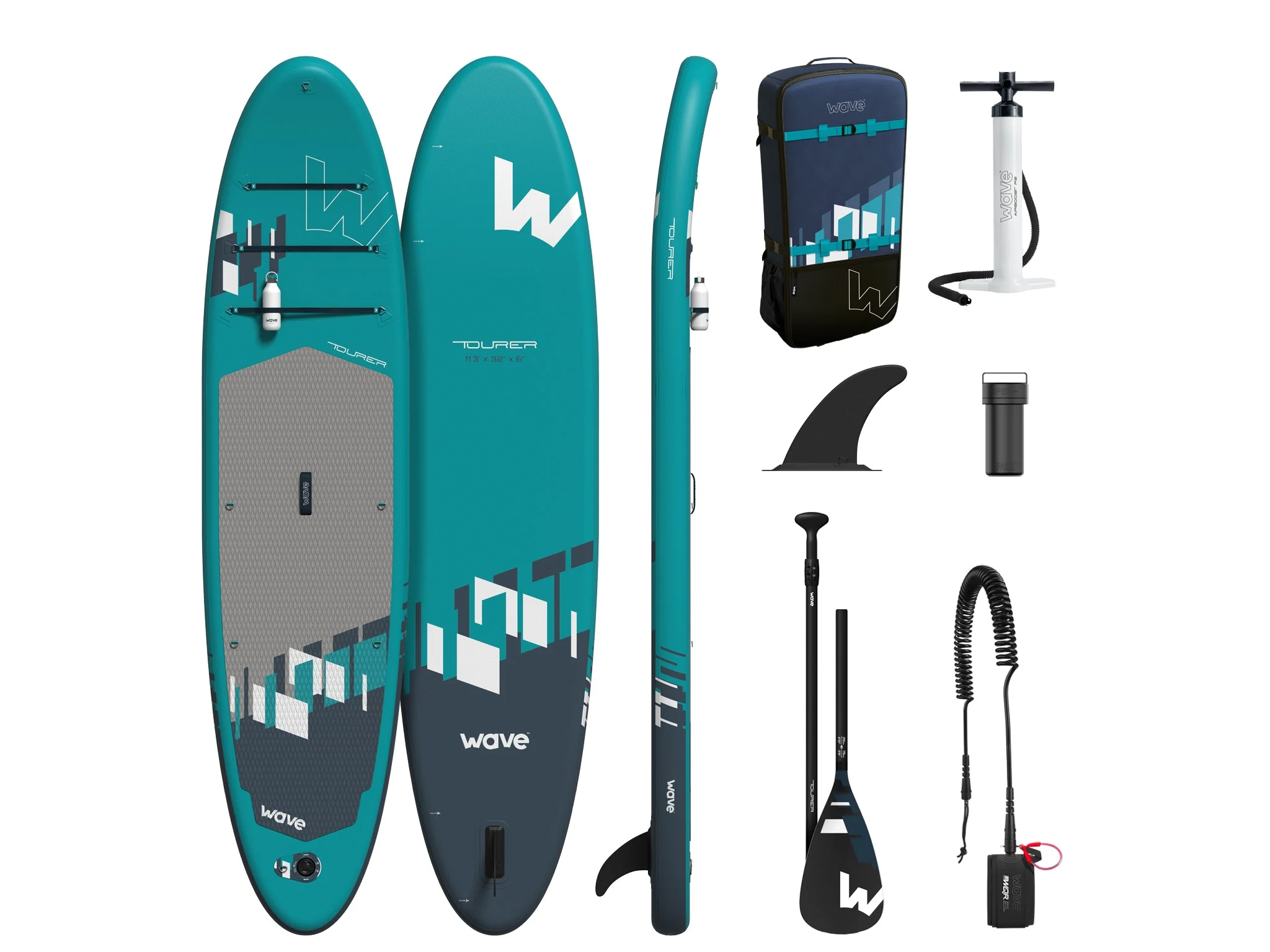
- Best: For taller boarders
- Length: 10ft 3in or 11ft 3in
- Width: 32in
- Depth: 6in
- Volume: Unspecified
- Max rider weight: 130kg or 140kg
- Package: Backpack, paddle, safety leash, dual-action pump
- Why we love it
- Lots of fun
- Great value
- Take note
- Bit unstable in choppy water
This is a great board, at a great price, from the Newcastle manufacturer, offering taller paddlers lots of stability.
Particularly suited for calmer waters, at just under 32in wide, it’s a quick board and offers good stability, while enabling you to progress your paddling skills and boost confidence. The foam deck pad offers lots of traction and will help keep you on your feet but it’s comfortable if you’re out for hours on end.
We inflated and deflated in around five minutes; there’s a three-bungee strap cargo area (with drinks holder), so plenty of room for extras; and the padded grab handle and light weight makes it a very portable board.
Red 10ft 2in ride MSL paddleboard
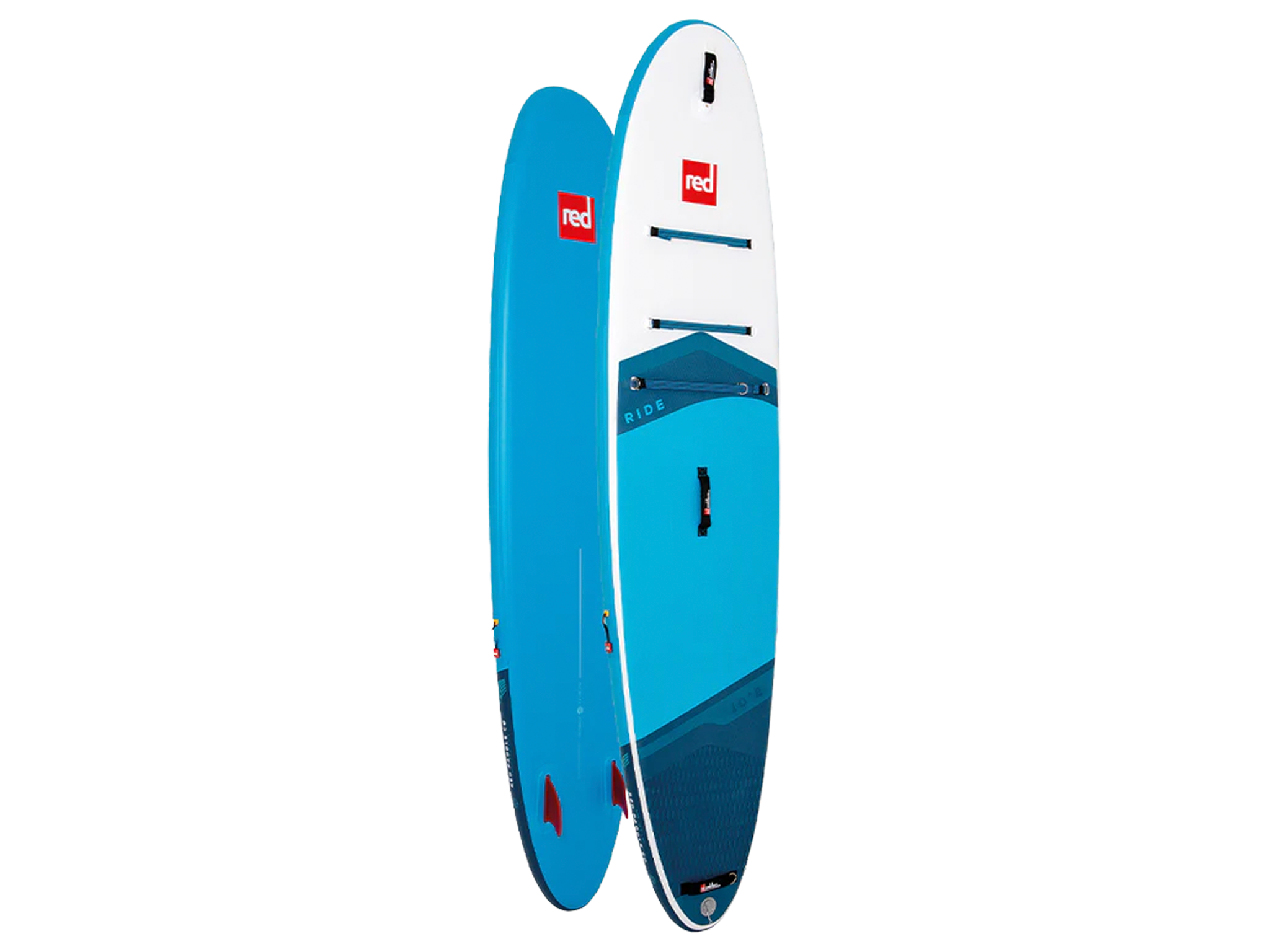
- Best: For lightweight paddlers
- Length: 10ft 2in
- Width: 29in
- Depth: 4in
- Volume: 182l
- Max rider weight: 90kg
- Package: Board carry strap, water-resistant phone case and safety leash
- Why we love it
- Feels stable
- Great for surfing
- Take note
- No paddle included in the basic package
- Low volume
Red has added to its extremely popular “ride” series of boards, with this easy paddler that’s well suited to younger, lighter boarders.
The brand has kept the rounded nose that’s characteristic of the series, so the board feels stable when you’re on it, despite its lower volume, but its slimmer width means it’s quick (the faster you go, the more stability will improve).
This is why it’s an excellent kids’ board or a good board to try SUP surfing, as it’s got bags of manoeuvrability and makes nice tight turns, the grip and comfortable deck pad also adds to its suitability for surfing and newbie riders.
As we’ve come to expect from Red, the construction is top notch and the board will be able to take plenty of punishment, without you having to worry about repairs. Nice and quick to inflate – great for impatient younger paddlers – the board has three carry handles, cargo straps and a safety leash, which is important for rookie riders and surfers alike.
Two Bare Feet entradia inflatable SUP ultimate pack
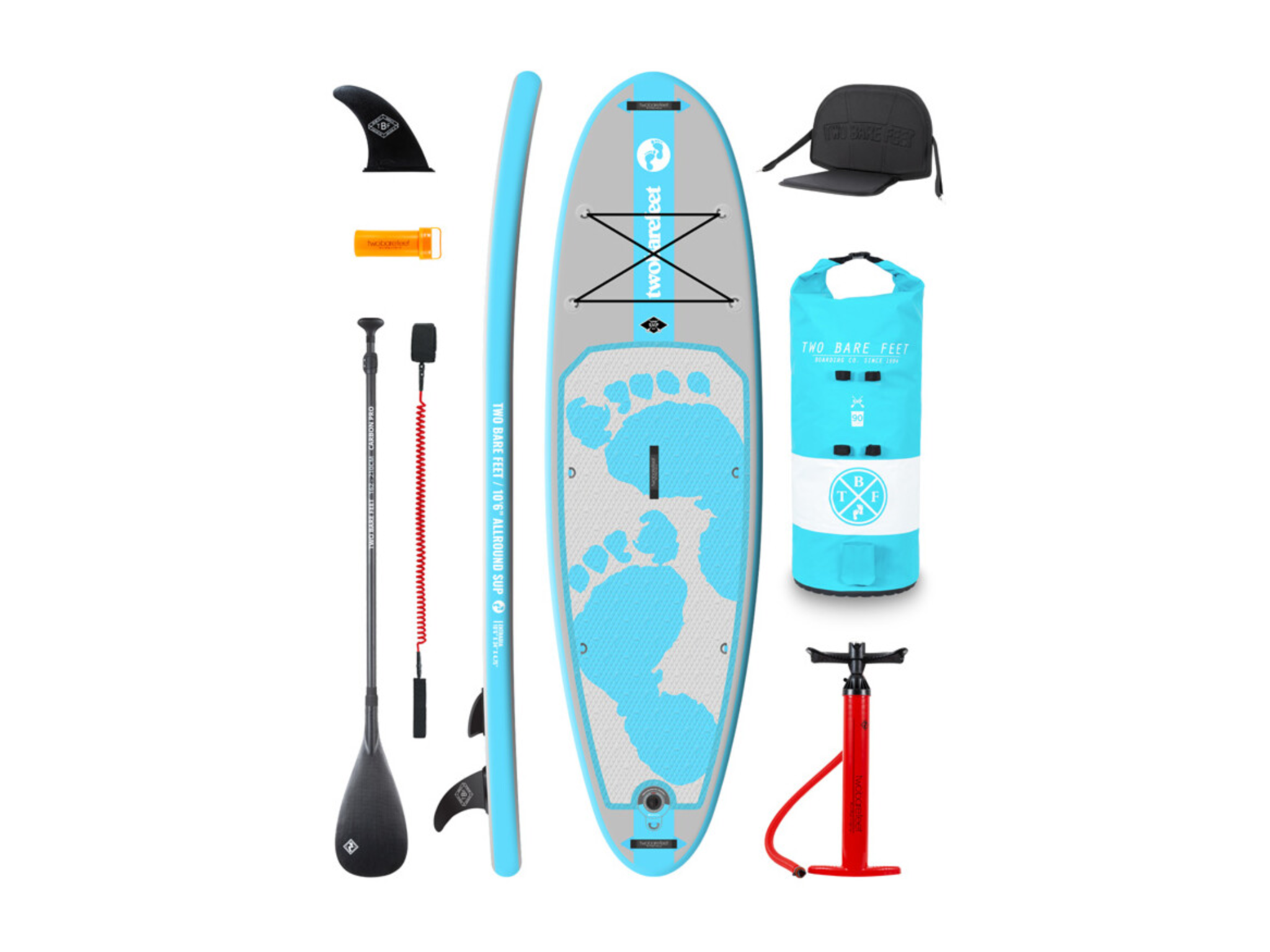
- Best: For beginners
- Length: 10ft 6in
- Width: 34in
- Depth: 4.75in
- Volume: 260l
- Max rider weight: 155kg
- Package: Board, pump, dry bag, paddle and leash
- Why we love it
- Great for beginners
- Super stable
This board is proving to be very popular in the UK, thanks to its suitability for those just getting into SUPing. However, this means it can be tricky to get your hands (and feet) on one.
It’s a great board with a 34in-wide deck, which makes it super stable, with much less movement side to side when paddling.
The board is solidly constructed, too, so you won’t have to worry about damage if you get up close and personal with jagged rocks or riverbanks while you’re learning. What’s more, it’s very competitively priced for a starter board.
Due to its popularity, this board is currently out of stock, but you can register with Two Bare Feet to be the first to know when the SUP is available again.
Stand-up paddleboard FAQs
What type of paddleboard should I buy?
The main decision you will have to make when picking the right board for you is whether you want an inflatable board or a solid one. Inflatable boards are excellent for those with limited storage space, for the same reason they are also easier to transport, and tend to be on the more affordable side. Surprisingly, inflatable boards are actually more durable than solid ones – due to quality boards being made of super-duper strong materials, they won't dent or scratch in the same way solid boards might. That being said, in terms of performance, solid boards tend to have the edge. They have a more agile approach to gliding through the water and, for those interested in SUP surfing, they are better at catching waves.
What size paddleboard do I need?
The general rule for SUPs is the larger the board is, the faster it is, whereas shorter boards are better for manoeuvrability, so the choice of size depends on your plans. Your height also plays a part – short boards (less than 10ft) are best for kids or those wanting to surf. Medium (10-12ft) is the most popular size, and best for general use as well as SUP yoga. Longboards (12-14ft) are ideal for fast-paced paddling or long-haul adventures.
What to wear when paddleboarding
First of all, we have to advise wearing safety gear before you hit the water. With waves and weather being so unpredictable, personal floatation devices of any kind can be vital. When it’s summer, your favourite swimsuits will do just fine, but in the winter (because SUP is a year-round all-weather sport) wetsuits, dry suits and some water shoes are good ideas. Rash vests are also a good idea year-round, to protect yourself from the environment. Of course, SPF is always a must, no matter the month.
The verdict: Stand-up paddleboards
Looking for a board that will grow with you as you progress your paddling skills? The Two Bare Feet sport air will boost your confidence, while still challenging you to progress your technique every time you go out. It comes with a great package, hardy construction, and, if you’re thinking of taking out the family pet (not the cat, obviously), this was one of the most dog-friendly boards we tested.
If your budget doesn’t stretch quite that far, we also love the Wave woody SUP. It’s well-equipped to take you wherever you want to go, whether that’s exploring the coast from the water, going point to point or just messing about with some friends.
Ready to brace the water? Find the best wetsuits for men and women
Voucher Codes








